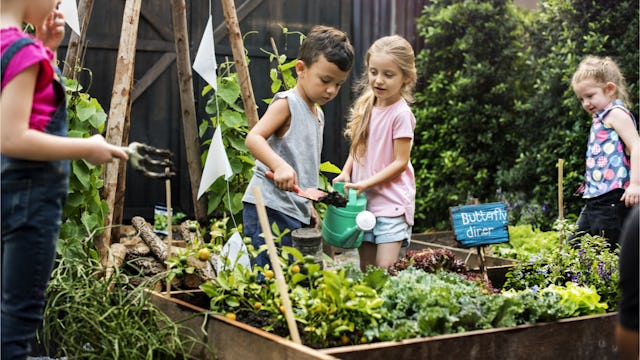Here's Why Every School Should Have A Garden

I don’t want to speak for everyone, but I somehow made it through a traditional education with a limited understanding of how to grow food. I mean, I knew that plants grew in dirt, but that was about it. The really sad part is I grew up next to my grandfather’s farm, so I was surrounded by food production. But like most ’90s teenagers, I was too preoccupied with Blink 182 and JNCO Jeans to pay much attention to where my food was coming from.
This was in the late ’90s, and naturally things have gotten worse, particularly when it comes to children living in urban areas where access to enough space to grow a garden is not available. The reality is, someone can only learn so much about gardening in the classroom, and growing food as part of a child’s upbringing isn’t all that pervasive anymore. That’s why many schools are now moving to build school gardens. In fact, there might be one in your child’s school right now. Your child might come home and complain about how much it stinks to get dirty for an hour or so or how boring it is to wait for food to grow.
I know this for a fact because my wife runs a school garden. It started this year. She works at a charter school that has a small greenhouse that was being sparsely used, so she and I put together a grant proposal to develop a program where students will learn about food production from the soil to the kitchen. The students will plant crops in actual dirt and learn about the plants, how they are harvested, and all the steps between the dirt and the kitchen. The end goal is for the children in the class to deliver their crops to the school cafeteria where they will be made into meals for the students to enjoy.
You might have noted that I wrote that in the future tense. The program was awarded a couple grants, and Mel is developing the program now. Just a few weeks ago, I got pretty sunburned building flowerbeds along with a couple other volunteers so that the children could fill them with dirt. Mel and her students are still waiting for the first crop to come in.
What Mel is doing in rural Oregon, however, is actually part of a national trend. According Dallas News, the REAL School Gardens out of Fort Worth has planted over 100 gardens and trained teachers how to use them. Scott Feille, executive director of REAL School Gardens, told Dallas News that teachers want their students “to have real-world experiences.”
In that same report, a former fifth-grade teacher said, “They want them to have an opportunity to get outside of the classroom, to get outside of the book, to have a space other than the classroom or oftentimes the apartment where they live that has very little green space and to experience the world in a hands on way.”
Ultimately, this is the hope for Mel’s program as well. However, there are many other benefits of a school garden. According to the REAL School Garden’s website, “REAL School Gardens = More Successful Students.” Their program has found that having a school garden results in a 15% increase in standardized test scores, and 94% of teachers report that they noticed an increase in student engagement. They also found that teachers love the garden, too, with many reporting an increase in job satisfaction. This is a big deal, folks, and it should be recognized.
I will admit that I have seen the stress that building a program from the ground up has had on Mel. She spends a good amount of time searching for outside funds, only to show up each day to a group of students who complain about having to get their hands dirty. But ultimately, that’s just teaching, gardening or otherwise. Both of us work in education, and I say with confidence that someone in the class is always bitching, and teachers are always trying to find funds for their students’ projects and classroom needs.
But on the whole, Mel often returns home with stories of children planting seeds for the first time in their lives. And I must say, in so many ways that’s a sad reality for children in 2017. Many of them don’t engage with their food outside of snagging it from the pantry. As a father, I wonder what damage that knowledge gap is having on children. That’s why I love the idea of programs such as school gardens trying to fill that gap and teach our kids the importance of sustainability and knowing where their food comes from (and the hard work it takes to get it to the dining room table).
If you are like me and this concerns you, see what you can do to make a change in your own school. Ask your school administrators to pursue building a school garden. I can’t give you a surefire path to creating a successful program, but what I can say is that Mel and I were able to find grants relatively easily (as easy as grant funding can be). It will take some pitching in, though, from the school and volunteers. Mel and I have had to do some of the heavy lifting, but what we have found is that many parents share our concerns and are willing to help because they, too, see the value in connecting our children with nature and food production.
This article was originally published on